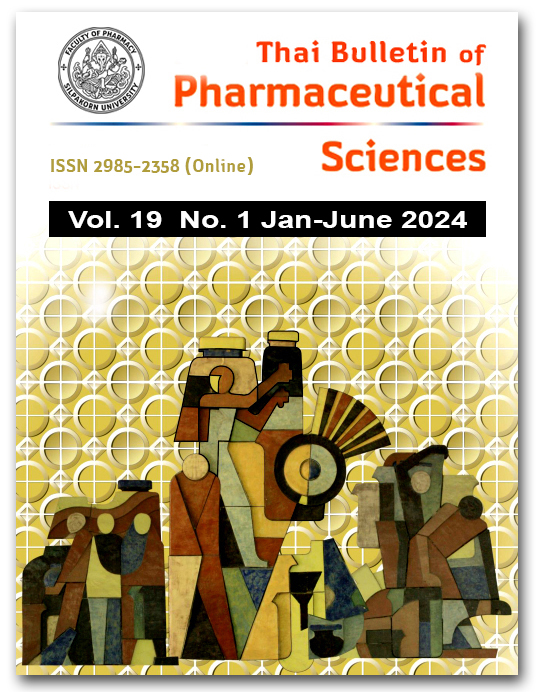DEVELOPMENT OF MEDICATION STOCK MANAGEMENT APPLICATION WITH AUGMENTED REALITY TECHNOLOGY
DOI:
https://doi.org/10.69598/tbps.19.1.19-33Keywords:
drug inventory management, augmented reality, applicationAbstract
Drug inventory management is part of a hospital pharmaceutical system that covers stocks of appropriate, safe, and high-quality medicines ready for use. In the management process, receiving or disbursing products, and current status reports were also processed on paper, not electronic documents. One management option is using mobile applications combined with augmented reality (AR) technology to help display product information. This research aimed to develop a program application for managing drug inventory by using AR technology that displays 2-dimensional images, Android mobile phones, and testing program applications. The results of the research found the program application could run according to the requirements that are consistent with the original work process, following 1) receiving products into the warehouse, 2) product disbursement, and 3) calling for a current report. The application was developed through related programs, namely Unity, Vuforia Engine, and Firestore. When the application was tested in actual work processes, it was found that it could be used in drug management to receiving-delivering products and check products according to the original process system, especially clearly displaying drugs.
References
Papanithinan S. The role of PTC in the concept of pharmaceutical policy driving to achieve safety according to HA 5th Edition [Internet]. 2023 [cited 2023 Jan 15]. Available from: https://ccpe.pharmacycouncil.org/index.php?option=article_detail&subpage=article_detail&id=1317 (in Thai)
The Association of Hospital Pharmacist (Thailand). Fundamental framework for medication management system [Internet]. 2020 [cited 2023 June 20]. Available from: https://backend.ha.or.th/fileupload/DOCUMENT/00514/72647587-6d96-428e-8de6-9f9c3fd88776.pdf (in Thai)
Sirisrisornchai T. The characteristics of hospital logistics in Thailand. J Thai Med Inform Assoc. 2022;8(2):86-92. (in Thai)
Awaya T, Ohtaki K, Yamada T, Yamamoto K, Miyoshi T, Itagaki Y, et al. Automation in drug inventory management saves personnel time and budget. Yakugaku Zasshi. 2005;125(5):427-32.
Hong-ying S. The application of barcode technology in logistics and warehouse management. Proceedings of the 1st International Workshop on Education Technology and Computer Science; 2009 Mar 7-8; Wuhan, China, IEEE; 2009. p. 732-5.
Kumwong W, Rungpragayphan S. Developing an internet of things device to track the temperature and humidity of medical storage. Thai Bull Pharm Sci. 2022;17(2):101-18. (in Thai)
Çakıcı ÖE, Groenevelt H, Seidmann A. Using RFID for the management of pharmaceutical inventory-system optimization and shrinkage control. Decis Support Syst. 2011;51(4):842–52.
Ginters E, Martin-Gutierrez J. Low cost augmented reality and RFID application for logistics items visualization. Procedia Comput Sci. 2013;26:3-13.
Khummin O, Sirawong N, Trirat N. Augmented reality technology to improve learners’s skill in the new normal. J Ind Educ. 2022;21(1):C9-15. (in Thai)
Takrudkaew B, Meesuwan W, Yuangsoi P. The development of augmented reality titled the King Naresuan. J Educ Naresuan Univ. 2017;19(4):133–43. (in Thai)
Noamna S, Thongphun K, Yodmongkol P. Application virtual world for cultural tourism. JIST. 2020;10(2):71-6. (in Thai)
Sari RC, Sholihin M, Yuniarti N, Purnama IA, Hermawan HD. Does behavior simulation based on augmented reality improve moral imagination? Educ Inf Technol. 2021;26(1):441-63.
Eckert M, Volmerg JS, Friedrich CM. Augmented reality in medicine: Systematic and bibliographic review. JMIR MHealth UHealth. 2019;7(4):e10967.
Gritcharoen J. Applying augmented reality for anatomy teaching and learning. Srinagarind Med J. 2020;35(1):98-102. (in Thai)
Nifakos S, Tomson T, Zary N. Combining physical and virtual contexts through augmented reality: Design and evaluation of a prototype using a drug box as a marker for antibiotic training. PeerJ. 2014;2:e697.
Ahmadvand A, Drennan J, Burgess J, Clark M, Kavanagh D, Burns K, et al. Novel augmented reality solution for improving health literacy around antihypertensives in people living with type 2 diabetes mellitus: Protocol of a technology evaluation study. BMJ Open. 2018;8(4):e019422.
Schneider J, Patfield M, Croft H, Salem S, Munro I. Introducing augmented reality technology to enhance learning in pharmacy education: A pilot study. Pharmacy (Basel). 2020;8(3):109.
Downloads
Published
How to Cite
Issue
Section
License
All articles published and information contained in this journal such as text, graphics, logos and images is copyrighted by and proprietary to the Thai Bulletin of Pharmaceutical Sciences, and may not be reproduced in whole or in part by persons, organizations, or corporations other than the Thai Bulletin of Pharmaceutical Sciences and the authors without prior written permission.



